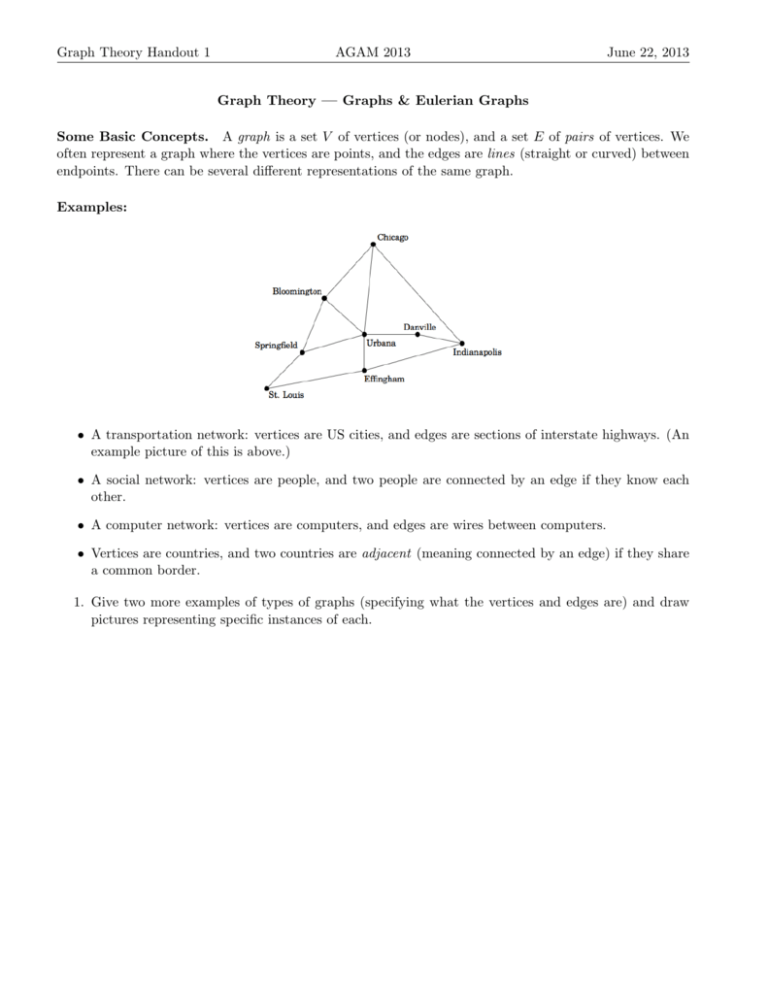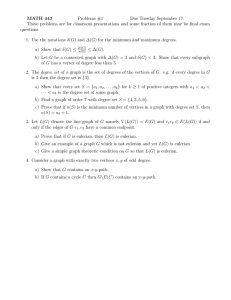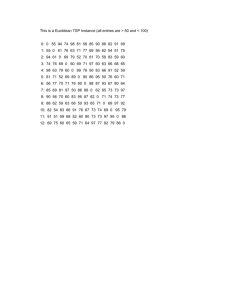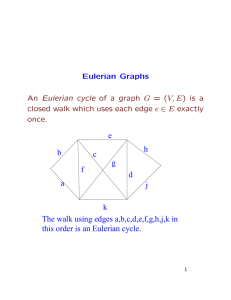here
advertisement

Graph Theory Handout 1 AGAM 2013 June 22, 2013 Graph Theory — Graphs & Eulerian Graphs Some Basic Concepts. A graph is a set V of vertices (or nodes), and a set E of pairs of vertices. We often represent a graph where the vertices are points, and the edges are lines (straight or curved) between endpoints. There can be several different representations of the same graph. Examples: • A transportation network: vertices are US cities, and edges are sections of interstate highways. (An example picture of this is above.) • A social network: vertices are people, and two people are connected by an edge if they know each other. • A computer network: vertices are computers, and edges are wires between computers. • Vertices are countries, and two countries are adjacent (meaning connected by an edge) if they share a common border. 1. Give two more examples of types of graphs (specifying what the vertices and edges are) and draw pictures representing specific instances of each. Graph Theory Handout 1 AGAM 2013 June 22, 2013 Degrees The degree of a vertex is the number of edges incident to that vertex. For example, in the transportation network drawn on page 1, the degree of Chicago is 3 and the degree of Danville is 1. 2. For each graph you drew, count the number of vertices and the number of edges. 3. Compute the sum of the degrees of all the vertices in each previous graph. 4. What is a relationship between the number of edges and the sum of the degrees? 5. Can you explain why this relationship is true? (This relationship is called the degree sum formula.) Graph Theory Handout 1 AGAM 2013 June 22, 2013 Eulerian Tours In 1736, the great Swiss mathematician Leonhard Euler visited the city of Königsberg in Prussia (current day Kaliningrad in Russia). The city is built on the river Pregel, and has several bridges, as indicated on the map. The townspeople of Königsberg challenged tourists to take a walking tour of the city by starting at their hotel, crossing each bridge exactly once, and ending up back at the hotel. The townspeople of course assumed that the tourists would spend lots of money along the way. 6. Suppose your hotel is on the northern bank of the Pregel. Can you find such a tour? 7. Model the problem above using a graph. Sometimes we allow multiple edges between the same two vertices in a graph; we then call the graph a multigraph. If the graph has no multiple edges, we call it a simple graph. Whether we allow multiple edges or not depends on what we’re trying to model with the graph. Are multiple edges appropriate above? Graph Theory Handout 1 AGAM 2013 June 22, 2013 8. A walk through a graph that starts and ends at the same vertex and that uses each edge exactly once is called an Eulerian tour. Can you find an Eulerian tour in the graph below? 9. Can you give a characterization based on degrees for when a connected graph has an Eulerian tour? 10. Can you explain why this characterization is true? Graph Theory Handout 1 AGAM 2013 June 22, 2013 11. If you were drawing a graph that has an Eulerian tour, then you could draw every edge of the graph with just one stroke of your pencil. What is the fewest number of pencil strokes needed to draw all of the edges in a connected graph that does not have an Eulerian tour? (Remember that you are not allowed to trace over an edge already drawn.) Try this out on the graph below. 12. Suppose a mailman needs to deliver mail to a certain neighborhood, represented by a graph. He needs to finish his route where he started and he needs to go through every street at least once. The mailman does not want to waste time, so he wants the shortest route. Notice that if a graph has an Eulerian tour, he would chose to take an Eulerian tour. If the graph does not have an Eulerian tour, what is his most efficient method for delivering mail to the neighborhood? Try this out on the graph above. 13. Is there any graph that would result in the mailman using each edge twice? If so, draw one.











